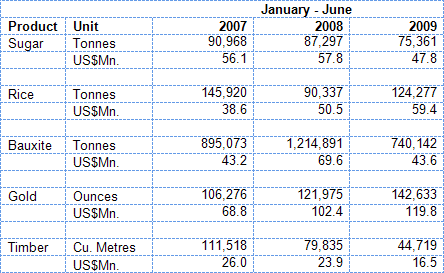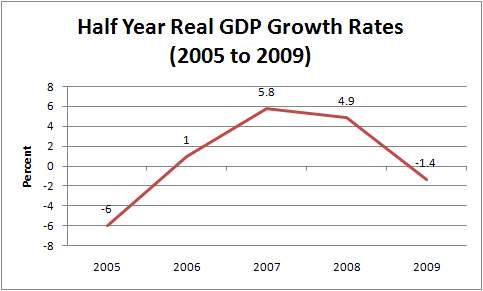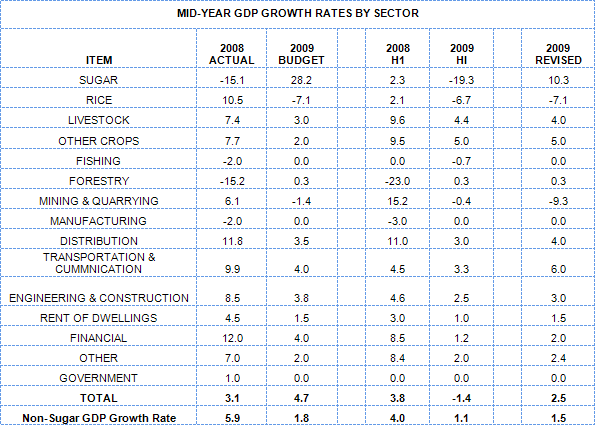Conclusion
This is the fourth and final part of a review of the Mid-year Report 2009 presented by the Minister of Finance to the National Assembly under the Fiscal Management and Accountability Act, 2003. As I promised last week, the purpose of this closing part is to pull the strands of the three preceding segments together and to look for any causes of optimism in the economy and its management.
Despite its title, the Act requires of the mid-year report more than the year-to-date execution of the annual budget. It requires the report to set out the prospects for the remainder of the year. It also mandates the inclusion of a revised economic outlook for the rest of the year, a statement of the projected impact of the trends on the remainder of the year, and very importantly, a list of major fiscal risks for the second half of the year with likely policy responses that the government proposes to take to meet the expected circumstances. In my view the report presented by the Minister falls very short of the requirements of the Act, and he spent no more than a few sentences on the revised economic outlook, fiscal risks and proposed government responses for the rest of the year. If proof be needed, then the Minister himself provided it this past week when he brought before the National Assembly requests for $5 billion, mainly for spending in the second half of the year, which must have qualified for – but did not receive – inclusion under projected trends and major fiscal risks. It is also a case of how bad and weak the Ministry of Finance is when it comes to budgeting and planning.
Before proceeding, I digress to repeat what I consider a major concern about the report, and that is its lack of timeliness and therefore its limited practical value. The report is by law due no later that August 30 of the year. It is now normal not only for the report to be issued months later, but also for it to bear a date that is very misleading, sending a signal to others that it is okay to do so. For 2009 it was presented on November 12, but bearing the date September 25. The Minister must be aware not only that the National Assembly has a registry to receive reports when it is in recess, but that it is wrong to send signals to subordinates that such conduct is acceptable.
Disdain
In part 2 of this short series I drew attention to an item in the Bank of Guyana Half-year Report submitted to the Minister of Finance, in which the performance of the economy in the first half of the year was addressed in considerable detail. I noted an obvious conflict between the numbers presented by the Minister and those presented by the Bank of Guyana; while one was reporting growth, the other was reporting a decline. Clearly they both could not be right, and the public would have expected, both out of duty and professional self-respect, either or both of these entities to have addressed the issue. Neither has done so, further evidence of the Minister’s disdain for the public, recalling his response to a Kaieteur News article on grossly excessive payment by the government for the purchase and supply of equipment, when he suggested that the newspaper should start bidding for contracts!
LCDS and accountability
The Minister must be aware that the President’s attempt to raise money internationally for Guyana’s proposed low carbon development strategy is also drawing attention to the country and its management. Everyone, including the General Secretary of the ruling party, now admits that corruption is taking place in the country – any difference being only the matter of degree, with most independent opinions leaning towards corruption on a massive scale. That view is reflected in Guyana’s ranking in the Corruption Perception Index by the internationally respected, German-based Transparency International, where Guyana is rated at 126 of 183 countries, the worst in the region.
This series on the mid-year report pointed to one of the most celebrated cases of flagrant breaches of financial procedures – that involving the purchase of drugs by the government, largely from an entity with which the President admitted to having close ties, and which had earlier been singled out for unlawful tax concessions. But that is only one case among many that are surfacing daily with contractors, whose low expertise in construction is only matched by high level connections, and who receive multi-million dollar contracts that cost as much in rework in some cases, almost as soon as the work is signed off and payment made. Corruption is one C-word that is alien to any half-year or full-year review done by the Minister.
Unlike the Minister of Finance and the President, Norway, the government’s LCDS benefactor, is not oblivious to or unaware of the endemic problems of corruption in Guyana, neither does it seem willing to sweep them under the carpet. That country’s Environment and International Development Minister Erik Solheim has made its position on corruption clear by prescribing robust anti-corruption measures before Guyana can draw down on the six-year US$250 million promise made by Norway. That understanding is still only at the MOU stage and may therefore be subject to further refinements and a formal and binding agreement.
Transparency
It is almost a joke to speak of a transparent financial mechanism while simultaneously and strongly refusing to put into effect constitutional provisions regarding the procurement of goods and services or an Audit Office headed and staffed by persons with appropriate qualifications. That the current head of the Audit Office is merely acting has as much to do with the fact that he has no professional accounting or audit qualification as that it serves the government well to have someone hold a key constitutional, accountability position purely at its whim and for its convenience. Those in acting positions know that if they rock the boat they risk sinking with it, a chance that out of self-interest, they will not take.
If the Norwegians are any more careful with their taxpayers’ funds than say the multilateral IDB or the World Bank, the chances of Guyana drawing down the entire sum must be low. If US$250M buys the Norwegians sufficient carbon credits to embellish their questionable record as an environment polluter, they may feel they have obtained a basement bargain. On the other hand, Guyana gives up major rights and opportunities, raising the question whether the country should not have had an indigenous low carbon development strategy rather than one dictated by the Norwegians, acting in their interest.
Contract employees
Another issue highlighted by this series was the increasing prevalence of the use of contract employees to get around the rules of employment in the public service. I had drawn attention to the more than $3 billion paid in salaries to this group of hand-picked persons, with another huge amount paid in benefits to them, including a 22% gratuity every six months. The really lucky ones get cars, drivers and duty concessions on top. This means that even the non-contract employees are really a benefit to the contract employees. Who these lucky ones are is intended to be a secret, but the Office of the President is a wonderful case of abuse. Of 201 employees in the Office of the President, ninety-five are contract employees and fifty-four are temporary. Among the contract employees are former ministers, all of whom are reported to be employed at the pleasure of the President on the same salaries and with the same benefits that they received as ministers. The Ministry of Local Government has two former ministers who must still be financed by the taxpayers.
Ironically, both the Public Service Commission and the Public Service Ministry which are expected to protect the integrity of the public service are themselves serial cases of the contract employee syndrome, while the culture also seems embedded in the Ministry of Culture, Youth and Sport.
Implications
The implications of this are huge and costly. It gets around the constitutional provisions for employment in the public service, creating a huge army of often highly paid loyalists but more importantly, it destroys the public service and its structures. What institutional memory will remain if on a change of government, the holders of all major key positions are not retained? Are we again going to turn to the British government which in the late eighties paid huge sums on financing a study that led to sweeping changes in the public sector and a dramatic reduction in the number of ministries? But that was before we had VAT that provides an annual windfall in revenues for the government to (mis)spend as it pleases, even as the half-year report discloses increasing borrowings without any indication of the actual amount of funds in the Treasury. That simply cannot be responsible financial management.
We noted in paragraph one that the Minister had approached the National Assembly for close to $5B to pay for unbudgeted expenditure on the army, Office of the President, LCDS, GuySuCo and other agencies and ministries. But we had also noted from the first-half report the low level of spending in that half year. The country’s financial rules provide for the reallocation of funds from one budget area to another. There is no indication that this sensible practice is ever employed instead of the simplistic approach for the National Assembly to rubber stamp excess and excessive spending. Simplistic too is its approach to sugar into which it continues to pump billions while its relationship with its major stakeholder – the workers – deteriorates rapidly. It is easy to forget that the government defied the World Bank and informed the public concerned about the Skeldon Project, the largest single public investment ever undertaken in this country. The results so far have been more than merely disappointing.
Where next?
Ram & McRae will this Thursday publish its report on its annual Business Outlook Survey which would give a good indication of the private sector’s take on the economy. From the empirical evidence only a few sectors are doing well but none of these is in manufacturing or production. Our financial sector continues to do well, as does distribution, but important as these are, they provide an intermediary function. The state-owned power company, whose costs feed into the rest of the economy, continues to struggle to reduce inefficiencies and costs. The public sector wage bill keeps mounting while services remain stagnant. The bureaucracy and its sibling, corruption, impose a huge cost on the highly-taxed economy, in which equity and fairness hardly exist.
It would not be right to argue that there have not been improvements in infrastructure, health and education, which were tied to the huge debt reliefs enjoyed over the past two decades. We have, however, failed in diversifying and strengthening our productive capabilities. Until we do that we cannot declare that we have accomplished the mission set by the PPP/C when it assumed control of this country, including making the country a place where rights, responsibilities and rewards were borne and shared equitably.




